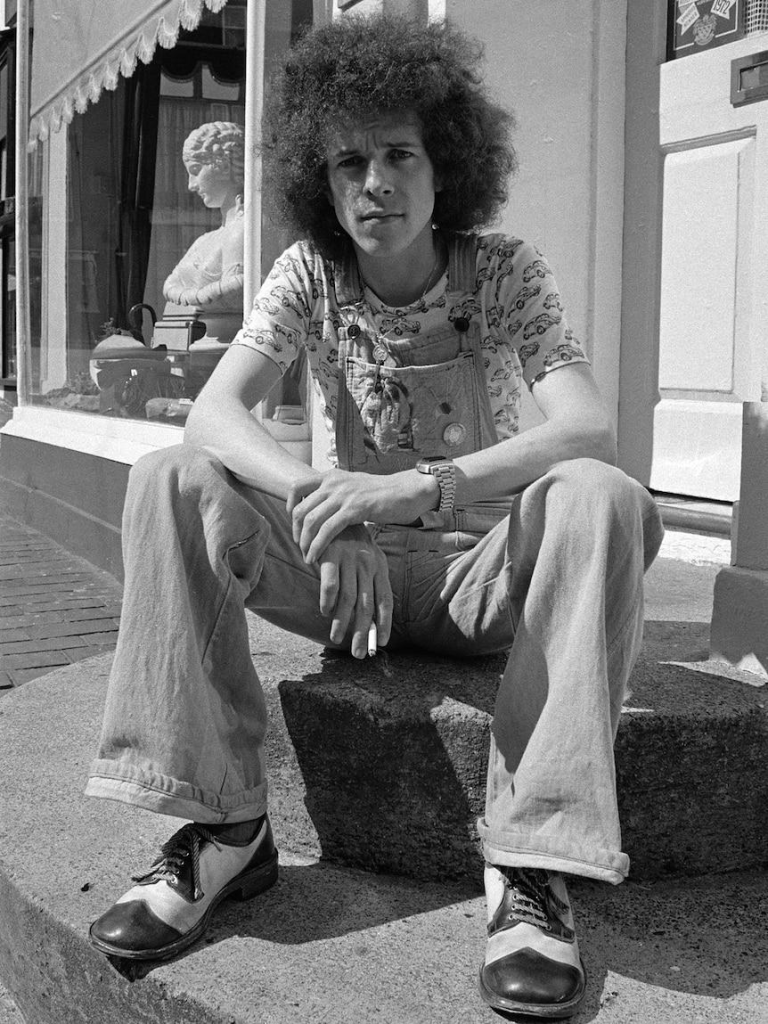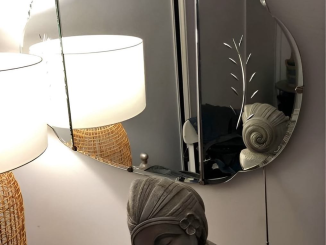“I look at my role as being a friend of Canberra Hospital, I can bring some pleasure and happiness sometimes to people who are really in difficult times in their lives.”
With backing music from a Bluetooth speaker, Sayer croons his way around the cancer wards, making a human connection with everyone he comes across.

Canberra Region Cancer Centre Operations Manager Caroline McIntyre says Sayer’s visits are typically kept a surprise for patients and staff.
“He’s always come in so discreetly,” she says.
“Normally it’s just very quiet, he comes up in the back lift and says hello to literally everybody.
“Some of them are doing it tough, and to have a little bit of joy and light – it really gives them a lift.
“What makes me happy is to see people getting chemo on their feet dancing.”
Jamming with Jimi Hendrix, Countdown and the Troubadour
Originally a graphic designer by trade, English-born Leo Sayer rose to pop prominence in London in the late 1960s, as a singer-songwriter – and was soon adopted by Australia as an honorary son after his first tour here in 1974.
He went on to become an Australian citizen in 2009.
Sayer was a regular on ABC TV’s Countdown during the 70s and 80s, performing chart-toppers like “You Make Me Feel Like Dancing”, “When I Need You”, “More Than I Could Say” and “Orchard Road”.

He blushingly admits they were wild days – when he didn’t always live up to his “good-guy” public persona.
“It was mad, I mean, Top of the Pops in England, Countdown over here,” he says.
“You were mobbed by the fans, I remember being dragged out of a limousine the first tour that I came here, and then speaking to crazy people like Molly Meldrum on TV and trying to sort of like take it all in.”
It seems hard to believe – the petite, well-spoken singer, with a mane of curly hair that inspired changing his name from Gerard to Leo – beating off mobs of screaming fangirls.
Sayer circulated in superstar company, becoming close friends with former Beatles George Harrison and Paul McCartney, collaborating with Roger Daltrey of The Who, and even sharing a sly cigarette or two with John Lennon and Yoko Ono who had a flat above his design studio.
“I met Jimi Hendrix right at the start of his career. I actually jammed with him, playing the harmonica, and him playing the guitar,” he says.
Recalling his 1975 opening night at the famous Troubadour Club in Los Angeles, he looked up to see an intimidating line-up of fans in the front row.

“It was David Bowie, Elton John, and ‘The Fonz’ [Henry Winkler].”
Alongside them: John Cleese, Mick Jagger, Bernie Taupin, and comedian Marty Feldman.
“We never thought it would last, we were adapting to things around us, writing songs about things that are around us,” he says.
“And we thought they were only for our generation — so the amazing thing is my music’s become like a fine wine, where you lay it down and years later, it becomes a collector’s item.
“We’re in an age where the music that I make, young kids are actually latching onto it now, and they’re finding that that generation and that style of music we made is as current now as anything.”
Sayer’s health battles, still spreading hope at 76
Leo Sayer says his hospital charity work caps off a career dedicated to providing joy through music.
“It’s a nice piece of synchronicity really, because I was born in the grounds of a hospital in Shoreham by Sea in Sussex, near Brighton in England,” Mr Sayer said.
“I suppose I’ve always felt comfortable in hospitals and being around hospitals.
“Growing up, my dad was a hospital engineer, Mum was a nurse, my sister was a matron.”

Sayer has health struggles of his own, including three stents in his heart, which help him have a genuine connection to the hospital patients he entertains.
“[My music] is providing something that isn’t taking away from any of the treatment that’s going on. It’s providing something that’s just putting a smile on peoples’ faces.
“Music is communication and that’s what this is all about, we’re communicating, we’re making people feel better.
“We’re not healing people with music, but we are making them feel better about their healing.
“To sell out Canberra Hospital will do me fine.”
Shania Twain: A Pop Star Who Overcame Adversity

The well-known Canadian singer-songwriter and best-selling female country music performer Shania Twain has an incredible tale of overcoming hardship. One of the numerous hardships she faced as a child growing up in a low-income environment was going to bed hungry. Even though she still views herself as lucky, she is now using her success to change the world.

At an early age, Twain started his path to fame. When she was eight years old, she began working at bars to support her family financially. Twain had a rough upbringing, but he has shown incredible resiliency and perseverance.
Twain suffered domestic abuse at the hands of her mother and stepfather when she was a small child. She said that her stepfather’s mindset was akin to that of Jekyll and Hyde, which made her childhood particularly difficult. Her family was often struggling financially as well; they frequently lacked the funds for basic expenses like food and rent.
Twain remembers the agony of starvation she had in school as well as the embarrassment she suffered due to her insufficient food intake. She was in a terrible condition, but she was too conceited to ask for help. She learned the value of strength and character development from this early fight.Throughout her life, Twain encountered numerous challenges, but she resisted letting them define who she was. She feels that her will to overcome her traumas and tribulations defines who she is, not the suffering and agony she went through. Twain became the strong woman she is now because of her tenacity and refusal to feel guilty about her upbringing.

When Twain’s mother and stepfather perished in an automobile accident, tragedy rocked her world. She gave up her dream of being a singer to support her younger brothers. But destiny had other ideas for her.
Twain was able to pursue a prosperous singing career because of her talent and perseverance. She has received several honors and recognitions, making her one of the most well-known musicians of all time. Many people have found inspiration in her incredible story.
Twain gives back these days by using her position and celebrity. She feeds underprivileged children and gives them a loving, safe atmosphere through her nonprofit initiative, Shania Kids Can. Twain has always been motivated to feed the underprivileged by her desire to positively impact the lives of others going through similar struggles to her own.

Twain, who lives with her family on a farm near Las Vegas, believes that she is lucky and gives thanks to God for her present situation. Despite having a challenging background, she overcome many obstacles to achieve incredible achievements and inspire hope in others.
The example set by Shania Twain’s life is the value of tenacity and using achievement for the benefit of society. Her story serves as an example for all of us, showing that we can overcome any challenge if we are nice and persistent.



Leave a Reply